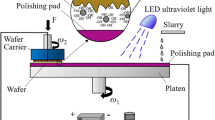Abstract
The effects of impurities on the removal of doped polysilicon in the chemical-mechanical polishing (CMP) process is discussed. It has been found that the Si-CMP is seriously retarded in the presence of boron impurities. In this paper, effects of several usually used n-and p-type impurities for polysilicon are investigated. Successive polishing was performed to reveal the correlation between the removal rate and the dopant concentration along the depth of polysilicon layer. The removal is seriously retarded for p-type samples and slightly enhanced for n-type samples. After excluding the interference from surface roughness, linear relationship was found between the resultant removal rate and the doping concentration. In this study, electrostatic interaction between the reactant ions and the ionized impurities at the silicon surface is proposed to be the primary factor to change the removal reaction rates. For p-type polysilicon etched in an alkaline aqueous solution, transport of OH− anions is hindered because OH− anions experience a repelling force in front of the negative-charged acceptors. Following the same principle, the removal reaction forn-type polysilicon is enhanced. However, the removal rate forn-type polysilicon is rather limited by surface reaction than by transport of reactant ions. As a consequence, the enhancement of removing n-type polysilicon is not so prominent as compated to the retardation effect found for removal of p-type polysilicon.
Similar content being viewed by others
References
C.Y. Chang and S.M. Sze, ULSI Technology (New York: McGraw-Hill Inc., 1996), Ch. 8
M. Nandakumar, A. Chatterjee, S. Sridhar, K. Joyner, M. Rodder, and I.C. Chen, IEDM Technol. Dig. (1998), 133 pp.
C.Y. Chang, H.T. Lin, and T.F. Lei, IEEE Electron Dev. Lett. 17, 100 (1996).
A.B.Y. Chan, C.T. Nguyen, and P.K. Ko, IEEE Trans. Electron Dev. 44, 455 (1997).
T.F. Lei, J.Y. Cheng, S.Y. Shiau, T.S. Chao, and C.S. Lai, IEEE Trans. Electron Dev. 45, 912 (1998).
W.L. Yang, C.-Y. Cheng, M.-S. Tsai, D.-G. Liu, and M.-S. Shieh, IEEE Electron Dev. Lett., 21, 218 (2000).
E. Steinsland, M. Nese, A. Hanneborg, R.W. Bernstein, H. Sandmo, and G. Kittilsland, Proc. 8th Int. Conf. Solid-State Sensors and Actuators and EUROSENSORS IX, (Piscataway, NJ: IEEE, 1995), pp. 190–193.
J.R. Senna and R.L. Smith, Proc. 8th Int. Conf. Solid-State Sensors and Actuators and EUROSENSORS IX (Piscataway, NJ: IEEE, 1995), pp. 194–197.
G.J. Pietsch, Y.J. Chabal, and G.S. Higashi, Surf. Sci. 331–333, 395 (1995).
Author information
Authors and Affiliations
Rights and permissions
About this article
Cite this article
Liu, DG., Tsai, M.S., Yang, W.L. et al. Effects of impurities on removal of polysilicon in chemical-mechanical polish. J. Electron. Mater. 30, 53–58 (2001). https://doi.org/10.1007/s11664-001-0214-9
Received:
Accepted:
Issue Date:
DOI: https://doi.org/10.1007/s11664-001-0214-9




